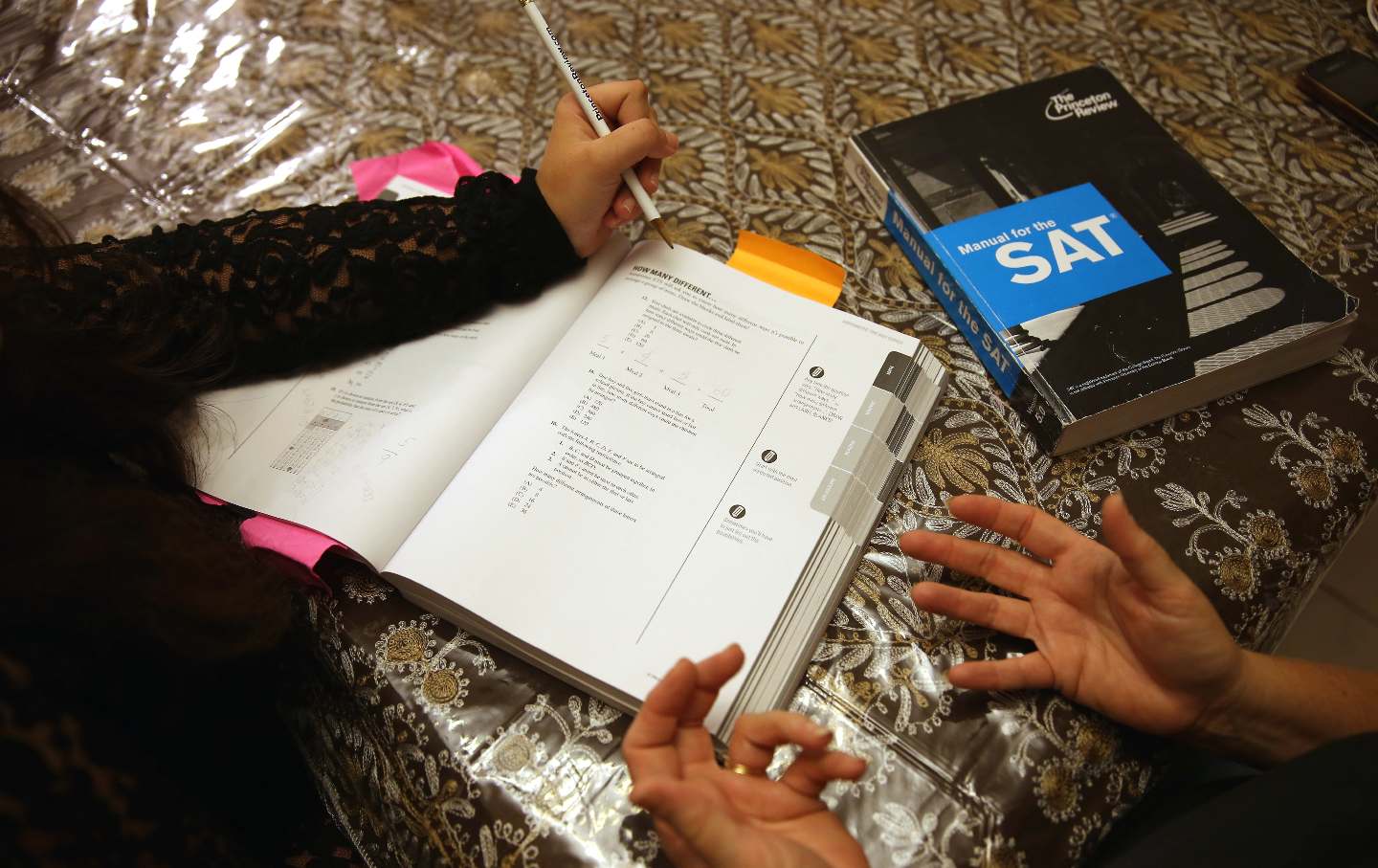Why Are Some Students Traveling Hundreds of Miles to Take the SAT?
Within minutes of registration opening for the test, every seat in my county and throughout Northern California was already reserved. I wasn’t alone.

A tutor goes over SAT test preparation with an 11th grader.
(Joe Raedle / Getty)
In Northern California, securing a spot to take the SAT feels like winning the lottery. Despite California State University and the University of California no longer requiring students to submit scores when applying, there is a severe scarcity of available testing sites in the Bay Area.
As a result, students are forced to make long-distance journeys to take the exam, turning an already stressful process into a logistical nightmare.
Dora Yang, a junior at Burlingame High School, found herself staying overnight in a Dallas, Texas motel, her mind racing with anxiety about the 8 AM exam the next day. Other students said they have traveled four hours to Fresno, California and six hours to Santa Barbara, California just to sit for the test.
When I attempted to sign up for the June 1 SAT, I logged on to the registration website the moment it opened. Within minutes, every seat in my county and across Northern California was already reserved. I wasn’t alone.
According to the College Board, the nonprofit organization that creates and administers the test, over 500,000 students took the SAT in California during the 2022-2023 school year. However, when 2024 sign-ups opened last spring, there were only 12 testing sites in the Bay Area, and—believe it or not—the August 24 test was fully booked across every location in the blink of an eye.
Less than half of the schools that had served as testing centers before the pandemic have since reopened, the College Board told the San Francisco Chronicle. In response, the College Board has been working to persuade those closed centers to reopen and has asked current test sites to increase seating. Last year, this effort led to 3,000 additional seats being added across seven new locations in California.
However, this year, more students are signing up for the SAT, driven by many schools reinstating their testing requirements. According to The Washington Post, after a significant drop in 2020 due to the sudden closure of test centers, the number of students taking the SAT has risen every year since, reaching 1.9 million for the class of 2023.
College Board spokesperson Holly Stepp acknowledged that another reason for the shortage of testing seats—particularly in the Bay Area and California—is that many site administrators are unwilling to oversee testing centers on weekends. Additionally, most California schools avoid administering the SAT during the school day, as some officials believe it disrupts students’ regular learning.
For the August 24 SAT testing date, a search on the College Board website revealed 123 testing sites within 100 miles of New York City, with 11 still offering available seats. Dallas had 70 sites, 22 of which still have openings. By contrast, the Bay Area had only 12 testing sites, all fully booked. The nearest available test center was 405 miles from San Francisco, placing Northern California students at a major disadvantage.
With only one testing site in Sacramento, Grant Union High School senior Jose Morales traveled two hours from Sacramento to Oakland on June 1, expecting a long morning of test taking and a desperate need for coffee. However, what he didn’t expect was the abrupt cancellation of the exam due to Wi-Fi troubles at the Marriott Hotel in downtown Oakland, leaving roughly 1,400 students scrambling for alternatives.
“We know that school officials don’t want to come in early on a Saturday, but it’s worse when your students have to scavenge for seats at other venues, let alone have those seats canceled after traveling long distances to get there,” said Morales.
While many fairly debate the relevance of the SAT, the test is often still a factor in college admissions. According to FairTest, only 4 percent of four-year colleges are test-blind, meaning they do not consider test scores at all. The majority, around 87 percent, are test-optional, and nine percent still require these exams. “This problem will become ever more prevalent with universities going back to requiring standardized tests,” Morales said.
If a score is not submitted, test-optional schools will simply base their admission decision off the rest of the application, but Lely High School senior Shamara Bornelus argues that scoring highly on the SAT as a person of color from a Title I school—meaning that a federal grant is provided to fund the school if at least 40 percent of their students come from low-income families and are considered at risk for scholastic achievement—can actually help to promote equity, and many college admissions officers share her view.
For Bornelus, she believes her current 1500 SAT score may be one selling component in the holistic admission process for test-optional schools. “I think lower income students who still score well, even if it is below average for a school, exemplify their dedication and their ability to handle the work they will do in college,” Bornelus said. “The SAT shows effort towards studying, and while it is one part of a college application, for schools that use the holistic admission process, which are many test-optional schools, every piece of information helps them to better understand you as an applicant, and I think the SAT really exemplifies that.”
In the past, the UC system’s faculty senate found that “a student admitted with a low SAT score is between two and five times more likely to drop out after one year, and up to three times less likely to complete their degree compared to a student with a high score.” In the past, some experts argued that the SAT inadvertently favors wealthier students who can hire counselors to help them with test prep classes, giving them a leverage over those who can’t afford the same, extra, treatments. But according to The New York Times, perhaps the strongest argument in favor of the tests is that other parts of the admissions process have even larger racial and economic biases: “Affluent students can participate in expensive activities, like music lessons and travel sports teams, that strengthen their applications.…. Well-off students can pay for test prep classes and can pay to take the tests multiple times. Yet the evidence suggests that these advantages cause a very small part of the [SAT] gaps.”
Students unable to take the test miss out on potential colleges and scholarships that consider or require SAT scores. This is especially detrimental for low-income families, where such scholarships could be the key to making college affordable. While lower-income students can’t afford expensive summer programs or private test prep, with the help of free SAT online resources like Khan Academy and a College Board fee test waiver, they can improve through practice and working hard. That is, if they can manage to secure a testing spot.
Popular
“swipe left below to view more authors”Swipe →Other standardized tests, like the California Assessment of Student Performance and Progress, are offered to all high school students at their schools during regular school hours. At Junipero Serra High School, alongside many other California private schools, SAT school days are a given. So why can’t all schools, public included, have the same?
The answer is simple: Only your school and district, according to the College Board, can choose whether to offer the in-class SAT testing day or not. Every school and district’s choice is independent from each other, and in most cases, your school and district can provide in-class SAT testing days if they have enough gathered student interest and adequate educational resources.
California students deserve equal access to college entrance exams, and it is up to the community to advocate for more testing sites and fairer testing conditions. Only through collective effort can we ensure that every student has the opportunity to achieve their college aspirations without unnecessary obstacles.
“[The] College Board needs to open availability—especially in California—for the amount of students [who want] to take this test [and not have to] travel for hours in order to do so,” Morales said. “Every student should be able to get registered [for] a test within 30 minutes of them, and I personally never want to travel the two hours I did in June again.”








